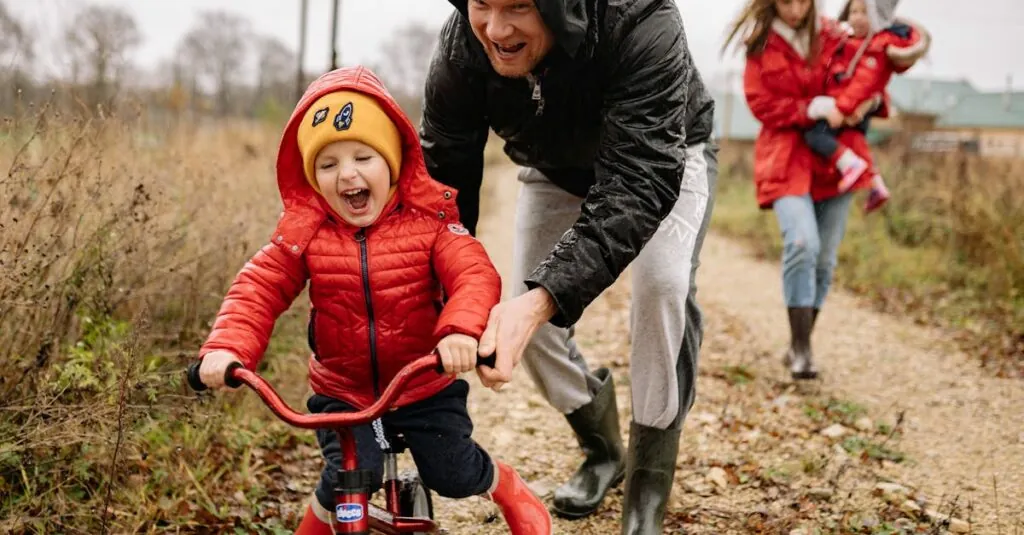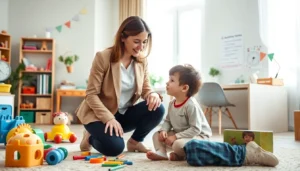Table of Contents
ToggleNavigating the emotional rollercoaster of childhood can feel like trying to tame a wild beast. One moment, a child’s laughter fills the air, and the next, it’s replaced by tears and tantrums that could rival a soap opera. Helping kids regulate their emotions isn’t just a nice-to-have; it’s a crucial skill that sets the stage for their future happiness and well-being.
Understanding Emotional Regulation
Understanding emotional regulation involves recognizing and managing feelings. This skill allows children to navigate their emotional experiences effectively.
What Is Emotional Regulation?
Emotional regulation refers to the methods people use to influence their emotional states. It includes recognizing emotions, managing responses, and expressing feelings appropriately. Children learn to identify emotions, leading to healthier interactions. Strategies can range from deep breathing to talking about feelings. Research shows that effective emotional regulation correlates strongly with social skills and academic performance. Developing this skill early promotes resilience in challenging situations.
Why Is Emotional Regulation Important for Kids?
Emotional regulation plays a crucial role in a child’s development. It contributes to better decision-making and problem-solving abilities. Kids who manage their emotions are more likely to form positive relationships. Difficulty with emotional regulation can lead to behavioral issues, anxiety, or depression. Children learn the impact of emotions on their actions, fostering empathy toward others. Mastering emotional regulation also enhances a child’s overall mental health, setting a foundation for lifelong emotional well-being.
Strategies for Helping Kids Regulate Emotions
Effective strategies exist for helping children regulate their emotions. These approaches build essential skills for emotional well-being.
Teaching Mindfulness Techniques
Teaching mindfulness techniques assists children in recognizing and managing their feelings. Breathing exercises, such as deep inhalations and slow exhales, help ground kids during emotional upheavals. Visualization also proves effective; guiding children to imagine a peaceful scene can reduce anxiety. Practicing gratitude encourages them to focus on positive aspects of life, fostering resilience. Engaging in mindfulness activities regularly enhances a child’s ability to understand their emotional triggers, allowing better emotional control in stressful situations.
Encouraging Open Communication
Open communication plays a pivotal role in helping kids express their emotions. Creating a safe environment promotes honest conversations about feelings. Asking open-ended questions allows children to share their thoughts without fear of judgment. When adults model vulnerability, they teach children that emotions are normal and manageable. Validating their feelings encourages children to articulate their experiences, leading to healthier emotional regulation. Regular discussions about emotions strengthen the parent-child bond, reinforcing emotional security and support.
Tools and Resources for Parents
Parents can access various tools and resources to help children regulate their emotions effectively.
Books and Apps
Books designed for children often simplify emotional concepts, making them relatable. Titles such as “The Way I Feel” by Janan Cain offer clear insights into different emotions. Apps like “Breathe, Think, Do with Sesame” teach calming strategies through engaging activities. These resources provide children with practical techniques to identify and express their feelings. Reading together fosters discussions about emotional experiences, strengthening understanding. Apps also offer parents tracking features, allowing them to monitor emotional growth over time.
Workshops and Support Groups
Workshops provide parents with valuable strategies for emotional regulation. Local community centers often host sessions focused on mindfulness, teaching parents skills they can pass on. Support groups offer a safe space for sharing challenges and gaining insights from other parents. Collaboration with professionals such as child psychologists enriches these experiences. Participants learn various techniques, including role-play to practice emotional expression. Group discussions help normalize struggles, emphasizing that emotional regulation is an ongoing journey.
Role of Educators in Emotional Regulation
Educators play a significant role in fostering emotional regulation among children. They create an environment conducive to understanding and managing emotions effectively.
Classroom Strategies
Implementing classroom strategies supports children’s emotional growth. Teachers can introduce mindfulness practices like guided breathing exercises to help students identify their feelings. Incorporating social-emotional learning curricula helps children understand emotions and appropriate responses. Frequent group discussions about feelings encourage students to share experiences and build empathy. Visual aids, such as charts illustrating different emotions, serve as reference points in recognizing feelings. Reinforcing positive behavior through praise improves emotional awareness and encourages respectful communication.
Collaboration with Parents
Collaboration with parents enhances emotional regulation efforts. Engaging in regular communication with families invites feedback on children’s emotional experiences at home. Providing resources, such as recommended literature and tools, empowers parents to reinforce emotional skills outside of school. Organizing workshops that educate parents about emotional regulation techniques fosters a shared understanding. Encouraging parents to participate in school activities creates a unified approach to emotional growth. Sharing strategies like active listening helps both teachers and parents support children’s emotional expression consistently.
Conclusion
Helping children regulate their emotions is a vital investment in their future. By equipping them with the tools to understand and manage their feelings, parents and educators can foster resilience and emotional intelligence. The strategies outlined provide practical ways to create supportive environments where children feel safe to express themselves.
As kids learn to navigate their emotional landscapes, they not only enhance their social skills but also improve their academic performance. This journey of emotional growth paves the way for healthier relationships and a more fulfilling life. Prioritizing emotional regulation today lays the groundwork for a brighter tomorrow.







